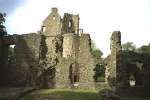Kings of Picts used the resource centred on what is now called Rhynie in Aberdeenshire and much gold used for the crown jewels, prior to Robert Bruce’s takeover, was Aberdeenshire gold.
Pearls were also sourced in Aberdeenshire from the River Ythan and the pearl in the Crown of Scotland (now in disuse) is from the Ythan (Buchan, outlet into North Sea north of Dee and Don). Kings prior to the Scots takeover AD843 had landholdings in Cé (present Aberdeenshire) and it remained one of the richest areas for royal hunting (Royal Forests of Derley, Deer, Gight, Garioch, Insch, Forgue, Cabrach, Letter (Ladder), Mar, Stocket and Udny & Dudwick); farming and artisan crafts.The most influential ‘Celtic’ earl before Robert I Bruce’s reshuffle was John Comyn Earl of Buchan, descended through marriage from Marjorie, last of the Pictish princesses of Derlei (Derley, Fyvie); and coincidentally nephew of John Balliol who was himself descended from the Pictish royal line through his mother Devorguila. When Bruce murdered John Comyn in Dunfermline in 1306 in order to secure Comyn lands and thereby claim Scots throne through wealth, Comyns rose as a tribe to fight back.

Ruinous Huntly Castle, Aberdeenshire whose heraldic doorway was personally hacked by monarch James VI
Comyns’ storehouse of gold (from Rhynie) was plundered and used to buy Bruce the kingdom of Scots. Bannockburn was merely a ‘follow-up’ battle in what is now colloquially called the ‘Central Belt’ to ensure Scotland’s independence from England. It was the nail in the coffin of the Buchan Pictish line.
Aberdeenshire’s grand houses from that time were no longer in use by the monarch, except in nominal annual visits or ‘progresses’ by the Royal House.
Fyvie and other castle strongholds of importance for previous royal patronage became private houses of the nobility which supported Bruce and his descendants. Rhynie gold and Ythan pearls descended into oblivion.
copyright 2009 Devorguila


